Integrating Sustainability in ICT Systems: Project for TTF Adelaide
VerifiedAdded on 2023/04/22
|8
|1535
|216
Project
AI Summary
This project report focuses on integrating sustainability into ICT systems, specifically for TTF Adelaide. It recommends strategies for reducing power consumption, including virtualization and energy-efficient servers. An energy audit compares PC and laser printer options, estimating CO2 emissions and financial costs. The report outlines a procurement policy for equipment from 'Green Suppliers' and a disposal plan for eco-friendly goods. A project implementation plan is detailed, emphasizing cost-effective and energy-efficient technologies to promote a conscious energy consumption culture. Additional tasks, such as conducting energy audits and implementing procurement policies, are listed with cost approximations. The project aims to introduce both short-term and long-term solutions for power saving within the organization. Desklib is a platform where you can find similar assignments and study resources.
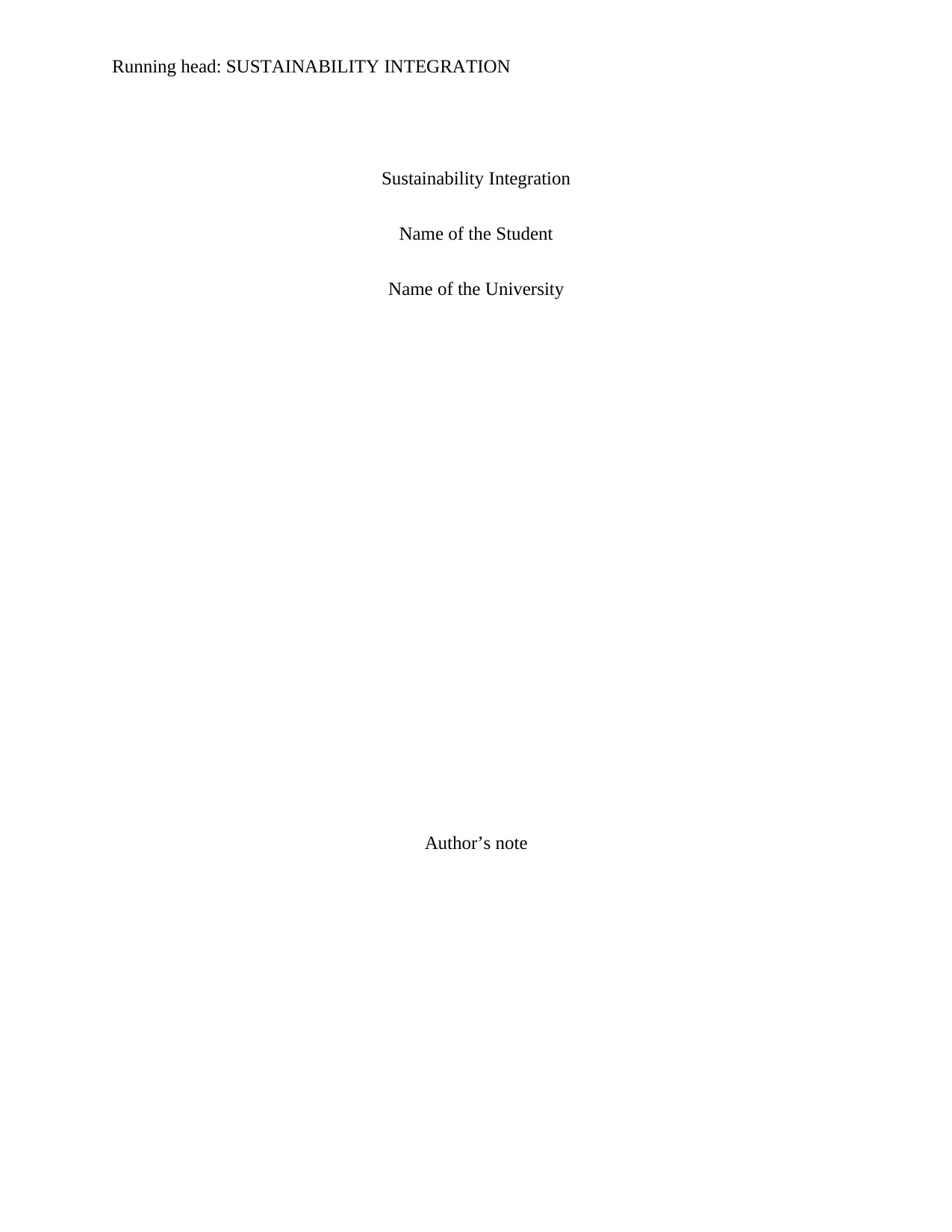
Running head: SUSTAINABILITY INTEGRATION
Sustainability Integration
Name of the Student
Name of the University
Author’s note
Sustainability Integration
Name of the Student
Name of the University
Author’s note
Paraphrase This Document
Need a fresh take? Get an instant paraphrase of this document with our AI Paraphraser
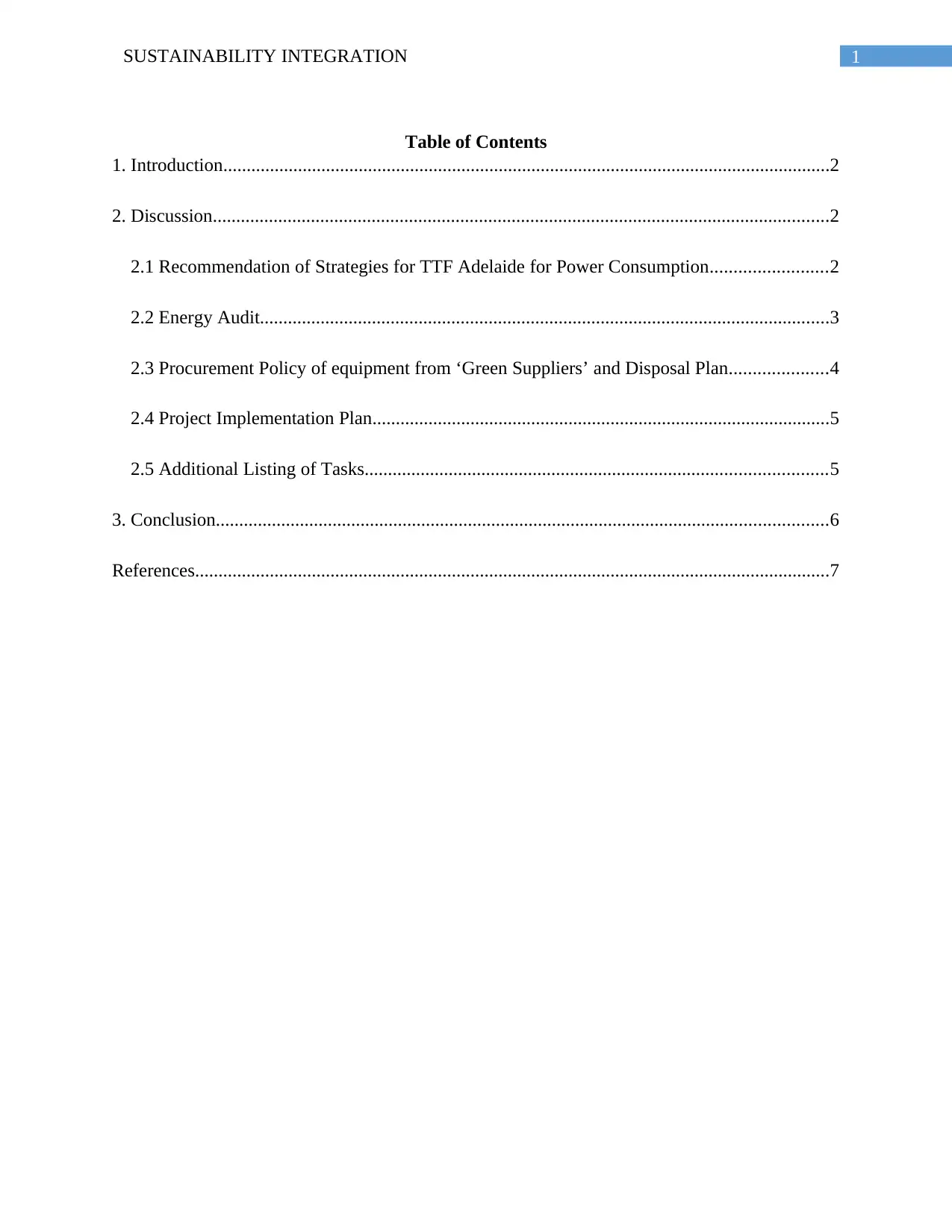
1SUSTAINABILITY INTEGRATION
Table of Contents
1. Introduction..................................................................................................................................2
2. Discussion....................................................................................................................................2
2.1 Recommendation of Strategies for TTF Adelaide for Power Consumption.........................2
2.2 Energy Audit..........................................................................................................................3
2.3 Procurement Policy of equipment from ‘Green Suppliers’ and Disposal Plan.....................4
2.4 Project Implementation Plan..................................................................................................5
2.5 Additional Listing of Tasks...................................................................................................5
3. Conclusion...................................................................................................................................6
References........................................................................................................................................7
Table of Contents
1. Introduction..................................................................................................................................2
2. Discussion....................................................................................................................................2
2.1 Recommendation of Strategies for TTF Adelaide for Power Consumption.........................2
2.2 Energy Audit..........................................................................................................................3
2.3 Procurement Policy of equipment from ‘Green Suppliers’ and Disposal Plan.....................4
2.4 Project Implementation Plan..................................................................................................5
2.5 Additional Listing of Tasks...................................................................................................5
3. Conclusion...................................................................................................................................6
References........................................................................................................................................7
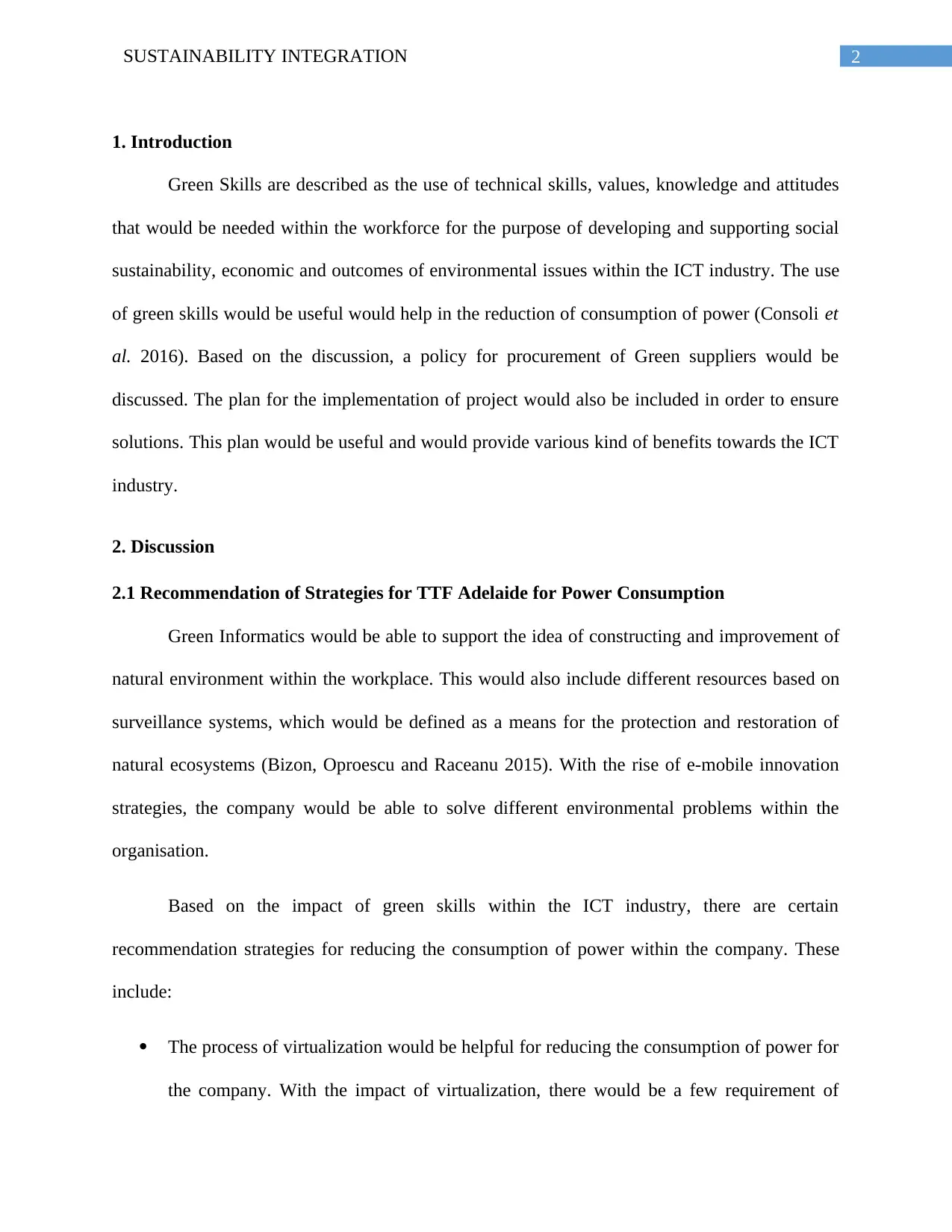
2SUSTAINABILITY INTEGRATION
1. Introduction
Green Skills are described as the use of technical skills, values, knowledge and attitudes
that would be needed within the workforce for the purpose of developing and supporting social
sustainability, economic and outcomes of environmental issues within the ICT industry. The use
of green skills would be useful would help in the reduction of consumption of power (Consoli et
al. 2016). Based on the discussion, a policy for procurement of Green suppliers would be
discussed. The plan for the implementation of project would also be included in order to ensure
solutions. This plan would be useful and would provide various kind of benefits towards the ICT
industry.
2. Discussion
2.1 Recommendation of Strategies for TTF Adelaide for Power Consumption
Green Informatics would be able to support the idea of constructing and improvement of
natural environment within the workplace. This would also include different resources based on
surveillance systems, which would be defined as a means for the protection and restoration of
natural ecosystems (Bizon, Oproescu and Raceanu 2015). With the rise of e-mobile innovation
strategies, the company would be able to solve different environmental problems within the
organisation.
Based on the impact of green skills within the ICT industry, there are certain
recommendation strategies for reducing the consumption of power within the company. These
include:
The process of virtualization would be helpful for reducing the consumption of power for
the company. With the impact of virtualization, there would be a few requirement of
1. Introduction
Green Skills are described as the use of technical skills, values, knowledge and attitudes
that would be needed within the workforce for the purpose of developing and supporting social
sustainability, economic and outcomes of environmental issues within the ICT industry. The use
of green skills would be useful would help in the reduction of consumption of power (Consoli et
al. 2016). Based on the discussion, a policy for procurement of Green suppliers would be
discussed. The plan for the implementation of project would also be included in order to ensure
solutions. This plan would be useful and would provide various kind of benefits towards the ICT
industry.
2. Discussion
2.1 Recommendation of Strategies for TTF Adelaide for Power Consumption
Green Informatics would be able to support the idea of constructing and improvement of
natural environment within the workplace. This would also include different resources based on
surveillance systems, which would be defined as a means for the protection and restoration of
natural ecosystems (Bizon, Oproescu and Raceanu 2015). With the rise of e-mobile innovation
strategies, the company would be able to solve different environmental problems within the
organisation.
Based on the impact of green skills within the ICT industry, there are certain
recommendation strategies for reducing the consumption of power within the company. These
include:
The process of virtualization would be helpful for reducing the consumption of power for
the company. With the impact of virtualization, there would be a few requirement of
⊘ This is a preview!⊘
Do you want full access?
Subscribe today to unlock all pages.

Trusted by 1+ million students worldwide
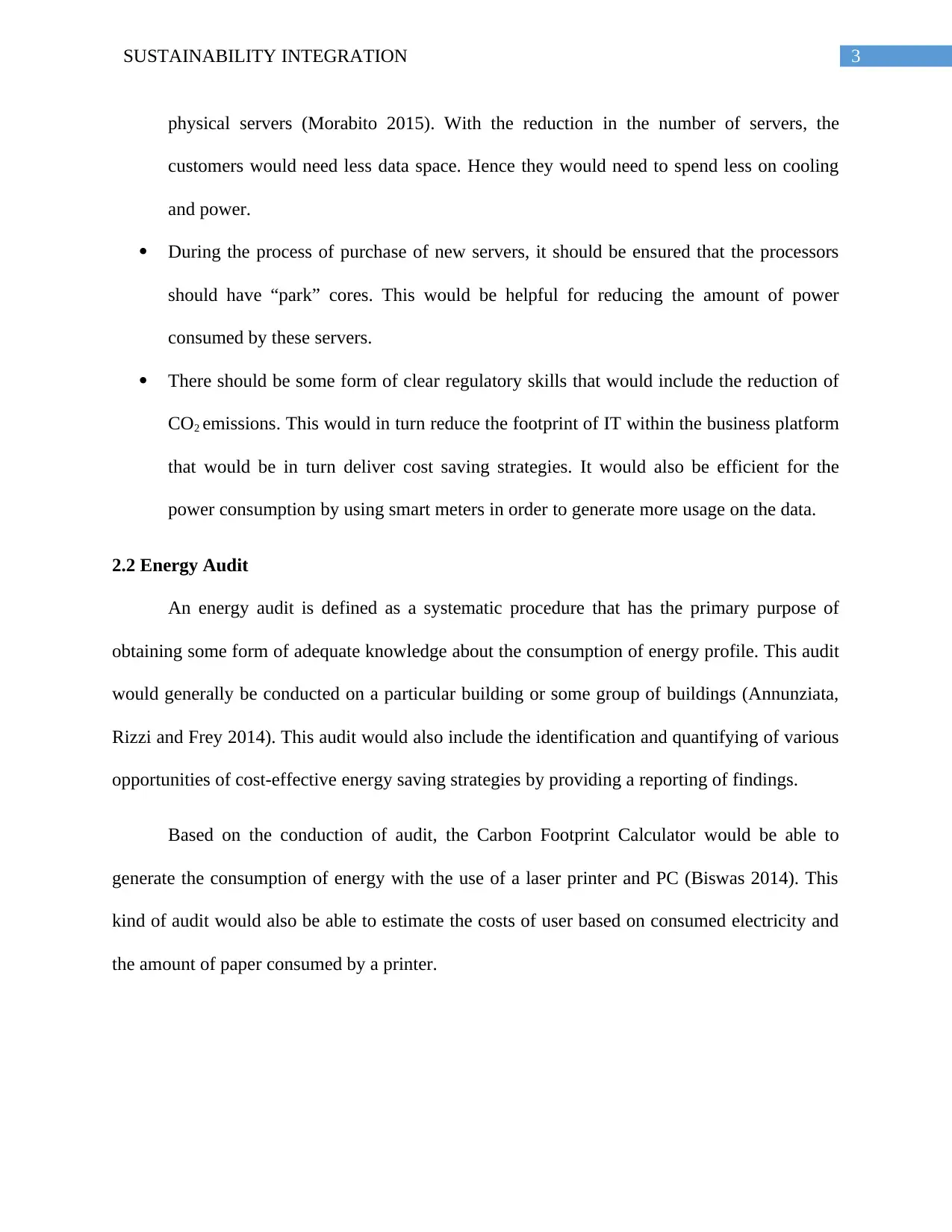
3SUSTAINABILITY INTEGRATION
physical servers (Morabito 2015). With the reduction in the number of servers, the
customers would need less data space. Hence they would need to spend less on cooling
and power.
During the process of purchase of new servers, it should be ensured that the processors
should have “park” cores. This would be helpful for reducing the amount of power
consumed by these servers.
There should be some form of clear regulatory skills that would include the reduction of
CO2 emissions. This would in turn reduce the footprint of IT within the business platform
that would be in turn deliver cost saving strategies. It would also be efficient for the
power consumption by using smart meters in order to generate more usage on the data.
2.2 Energy Audit
An energy audit is defined as a systematic procedure that has the primary purpose of
obtaining some form of adequate knowledge about the consumption of energy profile. This audit
would generally be conducted on a particular building or some group of buildings (Annunziata,
Rizzi and Frey 2014). This audit would also include the identification and quantifying of various
opportunities of cost-effective energy saving strategies by providing a reporting of findings.
Based on the conduction of audit, the Carbon Footprint Calculator would be able to
generate the consumption of energy with the use of a laser printer and PC (Biswas 2014). This
kind of audit would also be able to estimate the costs of user based on consumed electricity and
the amount of paper consumed by a printer.
physical servers (Morabito 2015). With the reduction in the number of servers, the
customers would need less data space. Hence they would need to spend less on cooling
and power.
During the process of purchase of new servers, it should be ensured that the processors
should have “park” cores. This would be helpful for reducing the amount of power
consumed by these servers.
There should be some form of clear regulatory skills that would include the reduction of
CO2 emissions. This would in turn reduce the footprint of IT within the business platform
that would be in turn deliver cost saving strategies. It would also be efficient for the
power consumption by using smart meters in order to generate more usage on the data.
2.2 Energy Audit
An energy audit is defined as a systematic procedure that has the primary purpose of
obtaining some form of adequate knowledge about the consumption of energy profile. This audit
would generally be conducted on a particular building or some group of buildings (Annunziata,
Rizzi and Frey 2014). This audit would also include the identification and quantifying of various
opportunities of cost-effective energy saving strategies by providing a reporting of findings.
Based on the conduction of audit, the Carbon Footprint Calculator would be able to
generate the consumption of energy with the use of a laser printer and PC (Biswas 2014). This
kind of audit would also be able to estimate the costs of user based on consumed electricity and
the amount of paper consumed by a printer.
Paraphrase This Document
Need a fresh take? Get an instant paraphrase of this document with our AI Paraphraser
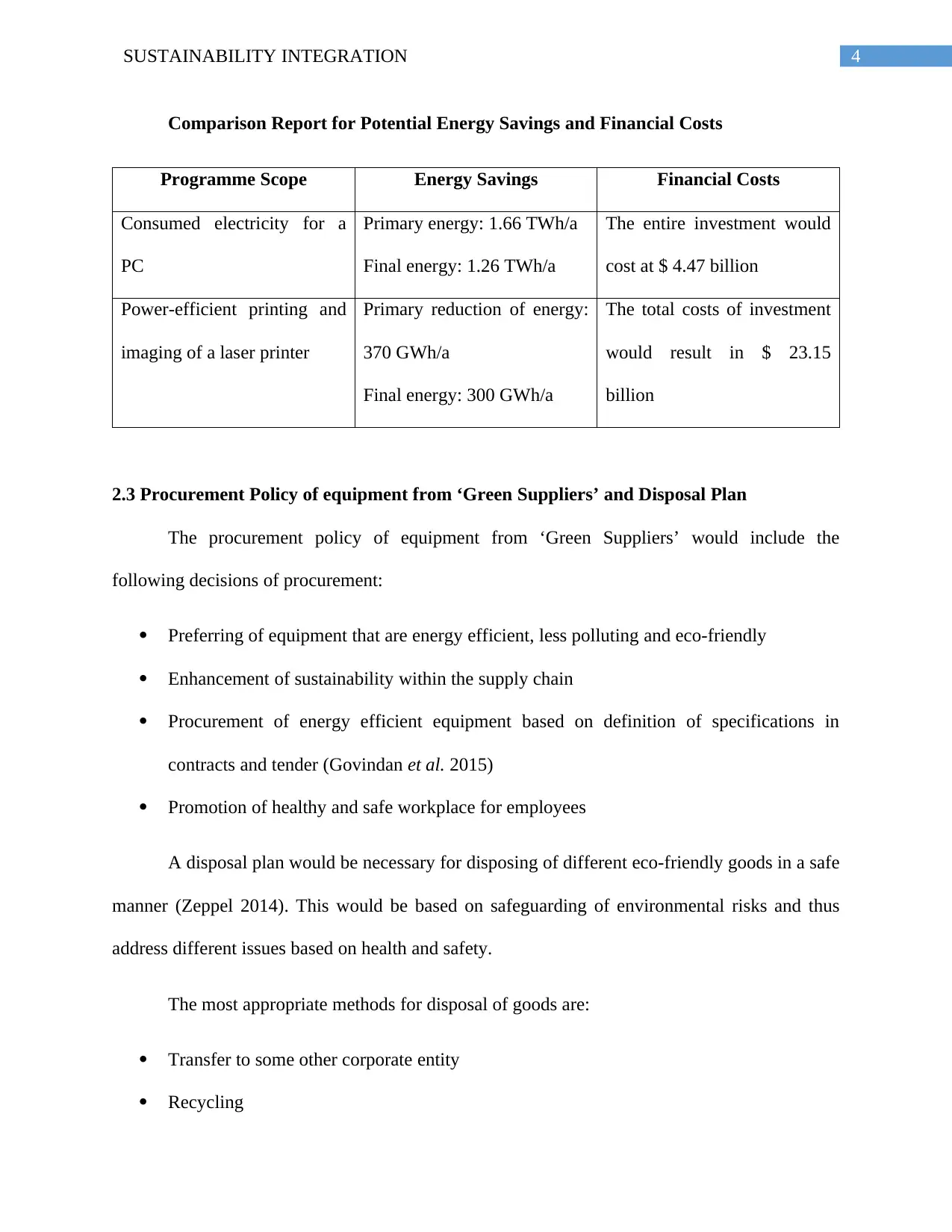
4SUSTAINABILITY INTEGRATION
Comparison Report for Potential Energy Savings and Financial Costs
Programme Scope Energy Savings Financial Costs
Consumed electricity for a
PC
Primary energy: 1.66 TWh/a
Final energy: 1.26 TWh/a
The entire investment would
cost at $ 4.47 billion
Power-efficient printing and
imaging of a laser printer
Primary reduction of energy:
370 GWh/a
Final energy: 300 GWh/a
The total costs of investment
would result in $ 23.15
billion
2.3 Procurement Policy of equipment from ‘Green Suppliers’ and Disposal Plan
The procurement policy of equipment from ‘Green Suppliers’ would include the
following decisions of procurement:
Preferring of equipment that are energy efficient, less polluting and eco-friendly
Enhancement of sustainability within the supply chain
Procurement of energy efficient equipment based on definition of specifications in
contracts and tender (Govindan et al. 2015)
Promotion of healthy and safe workplace for employees
A disposal plan would be necessary for disposing of different eco-friendly goods in a safe
manner (Zeppel 2014). This would be based on safeguarding of environmental risks and thus
address different issues based on health and safety.
The most appropriate methods for disposal of goods are:
Transfer to some other corporate entity
Recycling
Comparison Report for Potential Energy Savings and Financial Costs
Programme Scope Energy Savings Financial Costs
Consumed electricity for a
PC
Primary energy: 1.66 TWh/a
Final energy: 1.26 TWh/a
The entire investment would
cost at $ 4.47 billion
Power-efficient printing and
imaging of a laser printer
Primary reduction of energy:
370 GWh/a
Final energy: 300 GWh/a
The total costs of investment
would result in $ 23.15
billion
2.3 Procurement Policy of equipment from ‘Green Suppliers’ and Disposal Plan
The procurement policy of equipment from ‘Green Suppliers’ would include the
following decisions of procurement:
Preferring of equipment that are energy efficient, less polluting and eco-friendly
Enhancement of sustainability within the supply chain
Procurement of energy efficient equipment based on definition of specifications in
contracts and tender (Govindan et al. 2015)
Promotion of healthy and safe workplace for employees
A disposal plan would be necessary for disposing of different eco-friendly goods in a safe
manner (Zeppel 2014). This would be based on safeguarding of environmental risks and thus
address different issues based on health and safety.
The most appropriate methods for disposal of goods are:
Transfer to some other corporate entity
Recycling
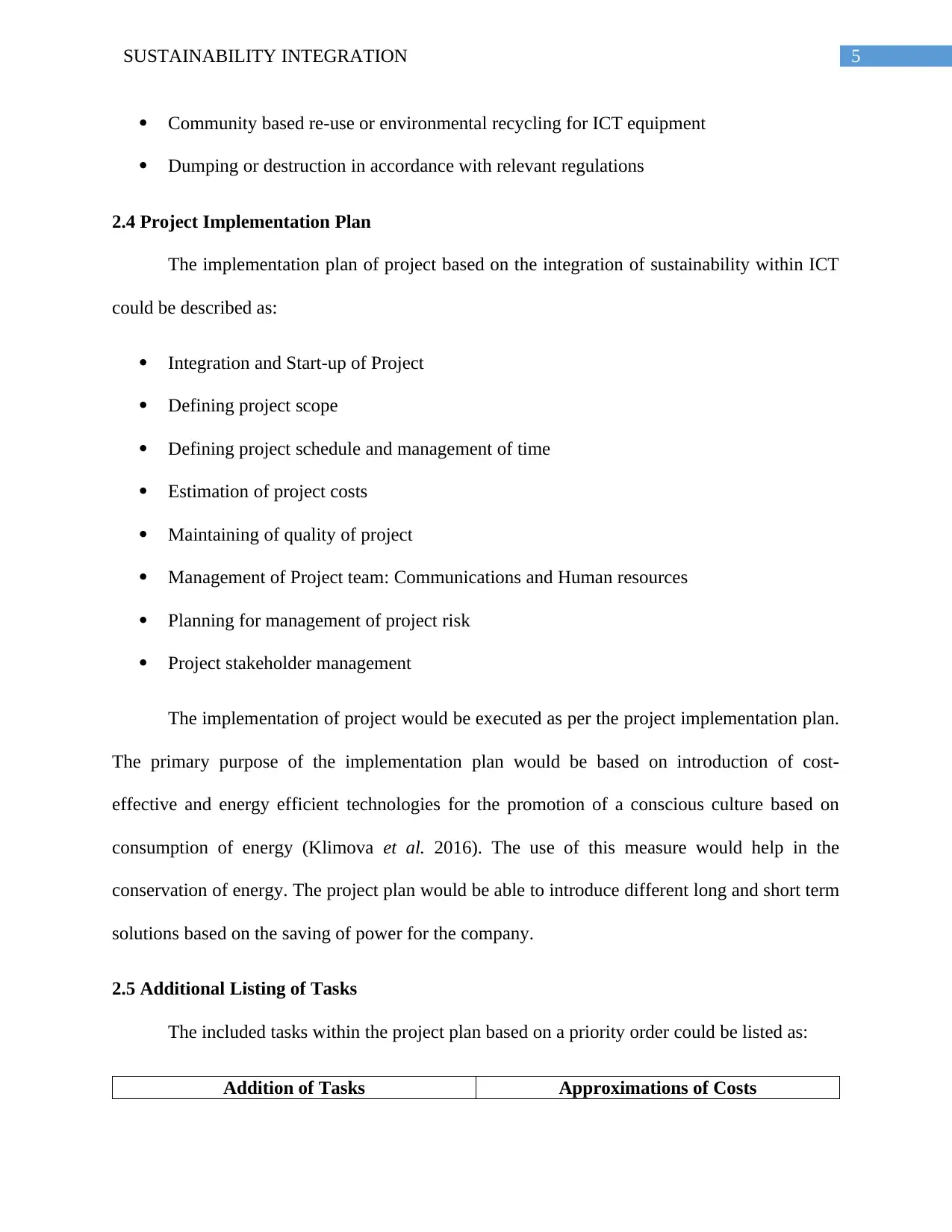
5SUSTAINABILITY INTEGRATION
Community based re-use or environmental recycling for ICT equipment
Dumping or destruction in accordance with relevant regulations
2.4 Project Implementation Plan
The implementation plan of project based on the integration of sustainability within ICT
could be described as:
Integration and Start-up of Project
Defining project scope
Defining project schedule and management of time
Estimation of project costs
Maintaining of quality of project
Management of Project team: Communications and Human resources
Planning for management of project risk
Project stakeholder management
The implementation of project would be executed as per the project implementation plan.
The primary purpose of the implementation plan would be based on introduction of cost-
effective and energy efficient technologies for the promotion of a conscious culture based on
consumption of energy (Klimova et al. 2016). The use of this measure would help in the
conservation of energy. The project plan would be able to introduce different long and short term
solutions based on the saving of power for the company.
2.5 Additional Listing of Tasks
The included tasks within the project plan based on a priority order could be listed as:
Addition of Tasks Approximations of Costs
Community based re-use or environmental recycling for ICT equipment
Dumping or destruction in accordance with relevant regulations
2.4 Project Implementation Plan
The implementation plan of project based on the integration of sustainability within ICT
could be described as:
Integration and Start-up of Project
Defining project scope
Defining project schedule and management of time
Estimation of project costs
Maintaining of quality of project
Management of Project team: Communications and Human resources
Planning for management of project risk
Project stakeholder management
The implementation of project would be executed as per the project implementation plan.
The primary purpose of the implementation plan would be based on introduction of cost-
effective and energy efficient technologies for the promotion of a conscious culture based on
consumption of energy (Klimova et al. 2016). The use of this measure would help in the
conservation of energy. The project plan would be able to introduce different long and short term
solutions based on the saving of power for the company.
2.5 Additional Listing of Tasks
The included tasks within the project plan based on a priority order could be listed as:
Addition of Tasks Approximations of Costs
⊘ This is a preview!⊘
Do you want full access?
Subscribe today to unlock all pages.

Trusted by 1+ million students worldwide
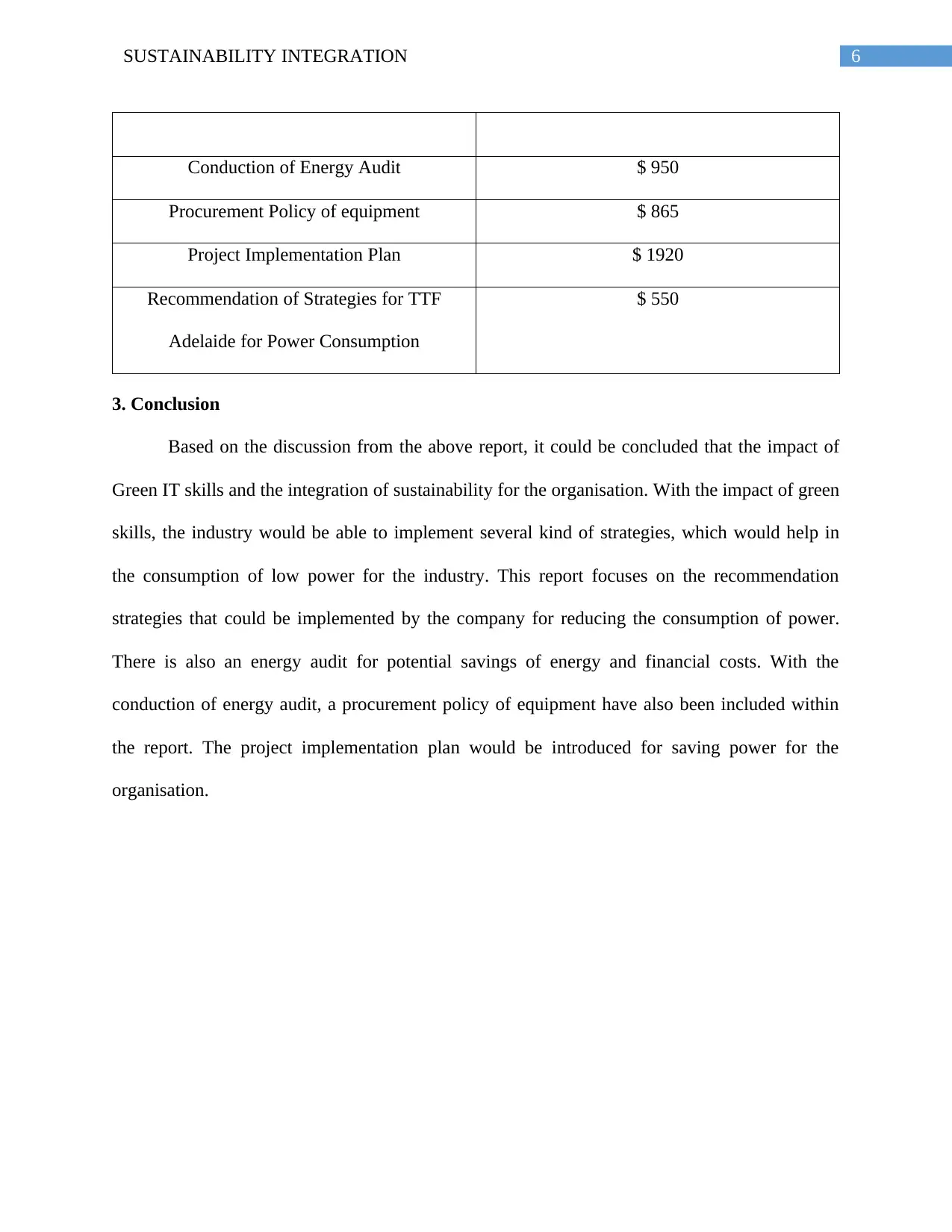
6SUSTAINABILITY INTEGRATION
Conduction of Energy Audit $ 950
Procurement Policy of equipment $ 865
Project Implementation Plan $ 1920
Recommendation of Strategies for TTF
Adelaide for Power Consumption
$ 550
3. Conclusion
Based on the discussion from the above report, it could be concluded that the impact of
Green IT skills and the integration of sustainability for the organisation. With the impact of green
skills, the industry would be able to implement several kind of strategies, which would help in
the consumption of low power for the industry. This report focuses on the recommendation
strategies that could be implemented by the company for reducing the consumption of power.
There is also an energy audit for potential savings of energy and financial costs. With the
conduction of energy audit, a procurement policy of equipment have also been included within
the report. The project implementation plan would be introduced for saving power for the
organisation.
Conduction of Energy Audit $ 950
Procurement Policy of equipment $ 865
Project Implementation Plan $ 1920
Recommendation of Strategies for TTF
Adelaide for Power Consumption
$ 550
3. Conclusion
Based on the discussion from the above report, it could be concluded that the impact of
Green IT skills and the integration of sustainability for the organisation. With the impact of green
skills, the industry would be able to implement several kind of strategies, which would help in
the consumption of low power for the industry. This report focuses on the recommendation
strategies that could be implemented by the company for reducing the consumption of power.
There is also an energy audit for potential savings of energy and financial costs. With the
conduction of energy audit, a procurement policy of equipment have also been included within
the report. The project implementation plan would be introduced for saving power for the
organisation.
Paraphrase This Document
Need a fresh take? Get an instant paraphrase of this document with our AI Paraphraser
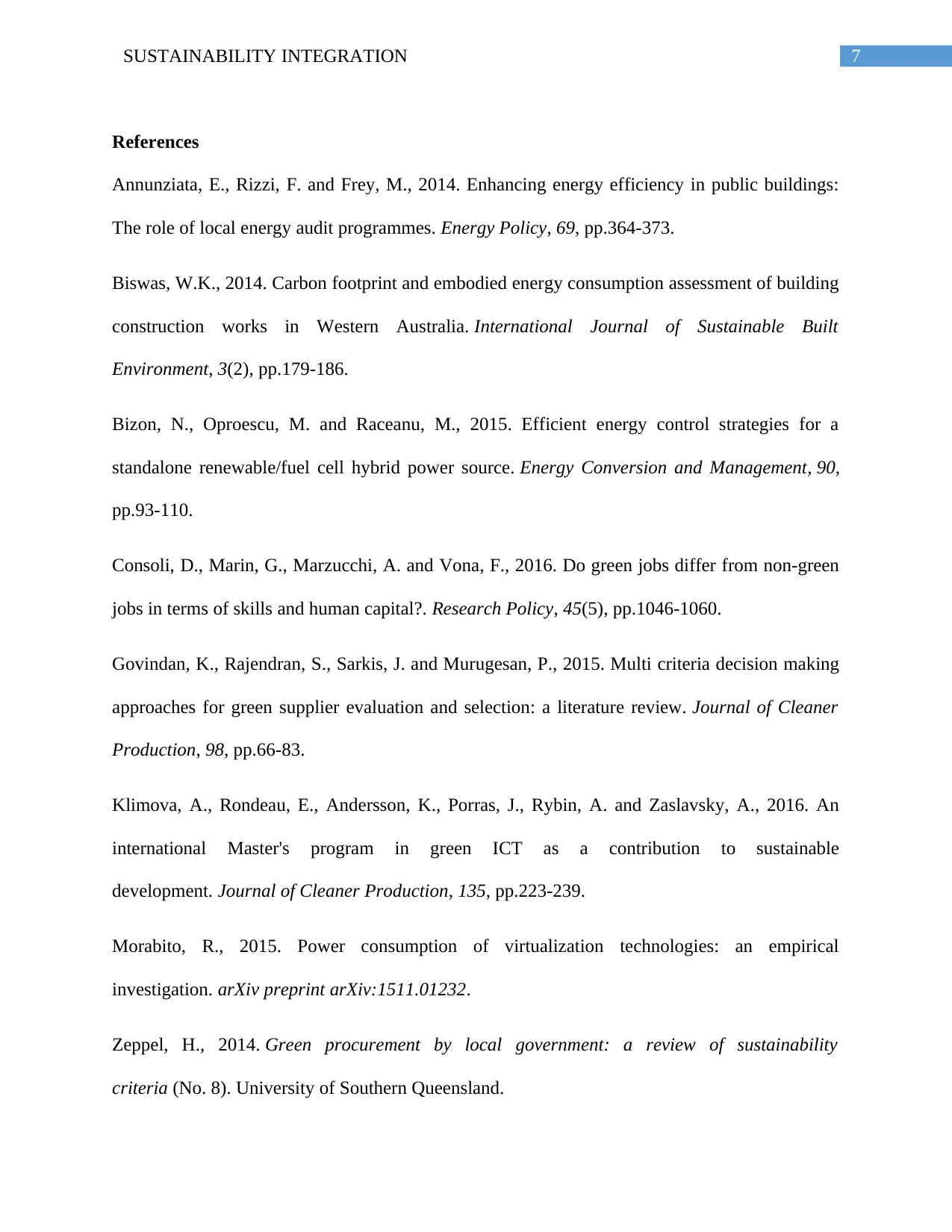
7SUSTAINABILITY INTEGRATION
References
Annunziata, E., Rizzi, F. and Frey, M., 2014. Enhancing energy efficiency in public buildings:
The role of local energy audit programmes. Energy Policy, 69, pp.364-373.
Biswas, W.K., 2014. Carbon footprint and embodied energy consumption assessment of building
construction works in Western Australia. International Journal of Sustainable Built
Environment, 3(2), pp.179-186.
Bizon, N., Oproescu, M. and Raceanu, M., 2015. Efficient energy control strategies for a
standalone renewable/fuel cell hybrid power source. Energy Conversion and Management, 90,
pp.93-110.
Consoli, D., Marin, G., Marzucchi, A. and Vona, F., 2016. Do green jobs differ from non-green
jobs in terms of skills and human capital?. Research Policy, 45(5), pp.1046-1060.
Govindan, K., Rajendran, S., Sarkis, J. and Murugesan, P., 2015. Multi criteria decision making
approaches for green supplier evaluation and selection: a literature review. Journal of Cleaner
Production, 98, pp.66-83.
Klimova, A., Rondeau, E., Andersson, K., Porras, J., Rybin, A. and Zaslavsky, A., 2016. An
international Master's program in green ICT as a contribution to sustainable
development. Journal of Cleaner Production, 135, pp.223-239.
Morabito, R., 2015. Power consumption of virtualization technologies: an empirical
investigation. arXiv preprint arXiv:1511.01232.
Zeppel, H., 2014. Green procurement by local government: a review of sustainability
criteria (No. 8). University of Southern Queensland.
References
Annunziata, E., Rizzi, F. and Frey, M., 2014. Enhancing energy efficiency in public buildings:
The role of local energy audit programmes. Energy Policy, 69, pp.364-373.
Biswas, W.K., 2014. Carbon footprint and embodied energy consumption assessment of building
construction works in Western Australia. International Journal of Sustainable Built
Environment, 3(2), pp.179-186.
Bizon, N., Oproescu, M. and Raceanu, M., 2015. Efficient energy control strategies for a
standalone renewable/fuel cell hybrid power source. Energy Conversion and Management, 90,
pp.93-110.
Consoli, D., Marin, G., Marzucchi, A. and Vona, F., 2016. Do green jobs differ from non-green
jobs in terms of skills and human capital?. Research Policy, 45(5), pp.1046-1060.
Govindan, K., Rajendran, S., Sarkis, J. and Murugesan, P., 2015. Multi criteria decision making
approaches for green supplier evaluation and selection: a literature review. Journal of Cleaner
Production, 98, pp.66-83.
Klimova, A., Rondeau, E., Andersson, K., Porras, J., Rybin, A. and Zaslavsky, A., 2016. An
international Master's program in green ICT as a contribution to sustainable
development. Journal of Cleaner Production, 135, pp.223-239.
Morabito, R., 2015. Power consumption of virtualization technologies: an empirical
investigation. arXiv preprint arXiv:1511.01232.
Zeppel, H., 2014. Green procurement by local government: a review of sustainability
criteria (No. 8). University of Southern Queensland.
1 out of 8
Related Documents
Your All-in-One AI-Powered Toolkit for Academic Success.
+13062052269
info@desklib.com
Available 24*7 on WhatsApp / Email
![[object Object]](/_next/static/media/star-bottom.7253800d.svg)
Unlock your academic potential
Copyright © 2020–2025 A2Z Services. All Rights Reserved. Developed and managed by ZUCOL.





